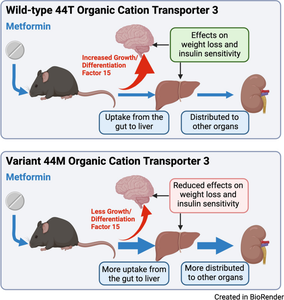Diabetologia ( IF 8.4 ) Pub Date : 2024-10-18 , DOI: 10.1007/s00125-024-06287-1 Qian Wang, Megan P. Leask, Kate Lee, Jagdish Jaiswal, Prasanna Kallingappa, Waruni Dissanayake, Chris Puli’uvea, Conor O’Sullivan, Huti Watson, Phillip Wilcox, Rinki Murphy, Troy L. Merry, Peter R. Shepherd

|
Aims/hypothesis
Metformin is an important first-line treatment for type 2 diabetes and acts by increasing the body’s ability to dispose of glucose. Metformin’s efficacy can be affected by genetic variants in the transporters that regulate its uptake into cells. The SLC22A3 gene (also known as EMT; EMTH; OCT3) codes for organic cation transporter 3 (OCT3), which is a broad-specificity cation transporter that also transports metformin. Most SLC22A3 variants reduce the rate of metformin transport but the rs8187715 variant (p.Thr44Met) is reported to increase uptake of metformin in vitro. However, the impact of this on in vivo metformin transport and efficacy is unknown. Very few carriers of this variant have been reported globally, but, notably, all were of Pacific Island descent. Therefore, this study aims to understand the prevalence of this variant in Polynesian peoples (Māori and Pacific peoples) and to understand its impact on metformin transport and efficacy in vivo.
Methods
rs8187715 was genotyped in 310 individuals with Māori and Pacific ancestry recruited in Aotearoa New Zealand. To study this variant in a physiological context, an orthologous knockin mouse model with C57BL/6J background was used. Pharmacokinetic analysis compared uptake rate of metformin into tissues. Plasma growth/differentiation factor 15 (GDF-15) was also measured as a marker of metformin efficacy. Glucose and insulin tolerance was assessed after acute or sustained metformin treatment in knockin and wild-type control mice to examine the impact of the variant on metformin’s glycaemic control.
Results
The minor allele frequency of this variant in the Māori and Pacific participants was 15.4%. There was no association of the variant with common metabolic parameters including diabetes status, BMI, blood pressure, lipids, or blood glucose and HbA1c. However, in the orthologous knockin mouse model, the rate of metformin uptake into the blood and tissues was increased. Acute metformin dosing increased insulin sensitivity in variant knockin mice but this effect was lost after longer-term metformin treatment. Metformin’s effects on GDF-15 levels were also lost in variant knockin mice with longer-term metformin treatment.
Conclusions/interpretation
These data provide evidence that the SLC22A3 rs8187715 variant accelerates metformin uptake rate in vivo. While this acutely improves insulin sensitivity, there was no increased effect of metformin with longer-term dosing. Thus, our finding of a high prevalence of this variant specifically in Māori and Pacific peoples identifies it as a potential population-specific pharmacogenetic marker with potential to guide metformin therapy in these peoples.
Graphical Abstract
中文翻译:

群体特异性 Thr44Met OCT3 编码变体影响二甲双胍药代动力学,随后对 C57Bl/6J 小鼠的胰岛素敏感性产生影响
目标/假设
二甲双胍是 2 型糖尿病的重要一线治疗药物,通过增加身体处理葡萄糖的能力发挥作用。二甲双胍的疗效会受到调节其被细胞摄取的转运蛋白的遗传变异的影响。SLC22A3 基因(也称为 EMT;EMTH;OCT3) 编码有机阳离子转运蛋白 3 (OCT3),OCT3 是一种广泛特异性的阳离子转运蛋白,也转运二甲双胍。大多数SLC22A3变体降低了二甲双胍的运输速率,但据报道 rs8187715 变体 (p.Thr44Met) 增加了二甲双胍在体外的摄取。然而,这对体内二甲双胍运输和疗效的影响尚不清楚。全球报道的这种变体的携带者很少,但值得注意的是,他们都是太平洋岛屿血统。因此,本研究旨在了解这种变体在波利尼西亚人民 (毛利人和太平洋人民) 中的普遍性,并了解其对二甲双胍运输和体内疗效的影响。
方法
rs8187715 在新西兰 Aotearoa 招募的 310 名具有毛利人和太平洋血统的个体中进行了基因分型。为了在生理学背景下研究这种变体,使用了具有 C57BL/6J 背景的直系同源敲入小鼠模型。药代动力学分析比较了二甲双胍在组织中的摄取率。血浆生长/分化因子 15 (GDF-15) 也被测量为二甲双胍疗效的标志物。在敲除和野生型对照小鼠急性或持续二甲双胍治疗后评估葡萄糖和胰岛素耐量,以检查该变体对二甲双胍血糖控制的影响。
结果
该变体在毛利人和太平洋参与者中的次要等位基因频率为 15.4%。该变异与常见的代谢参数(包括糖尿病状态、 BMI、血压、血脂或血糖和 HbA1c)没有关联。然而,在直系同源敲入小鼠模型中,二甲双胍进入血液和组织的摄取速率增加。急性二甲双胍给药增加了变异敲除小鼠的胰岛素敏感性,但在长期二甲双胍治疗后这种效果消失了。二甲双胍对 GDF-15 水平的影响在接受长期二甲双胍治疗的变异敲入小鼠中也丢失了。
结论/解释
这些数据提供了证据,证明 SLC22A3 rs8187715 变体可加速体内二甲双胍的摄取速度。虽然这大大提高了胰岛素敏感性,但长期给药后二甲双胍的效果没有增加。因此,我们发现这种变体在毛利人和太平洋人中的患病率很高,这使其成为一种潜在的人群特异性药物遗传学标志物,有可能指导这些人群的二甲双胍治疗。






























 京公网安备 11010802027423号
京公网安备 11010802027423号